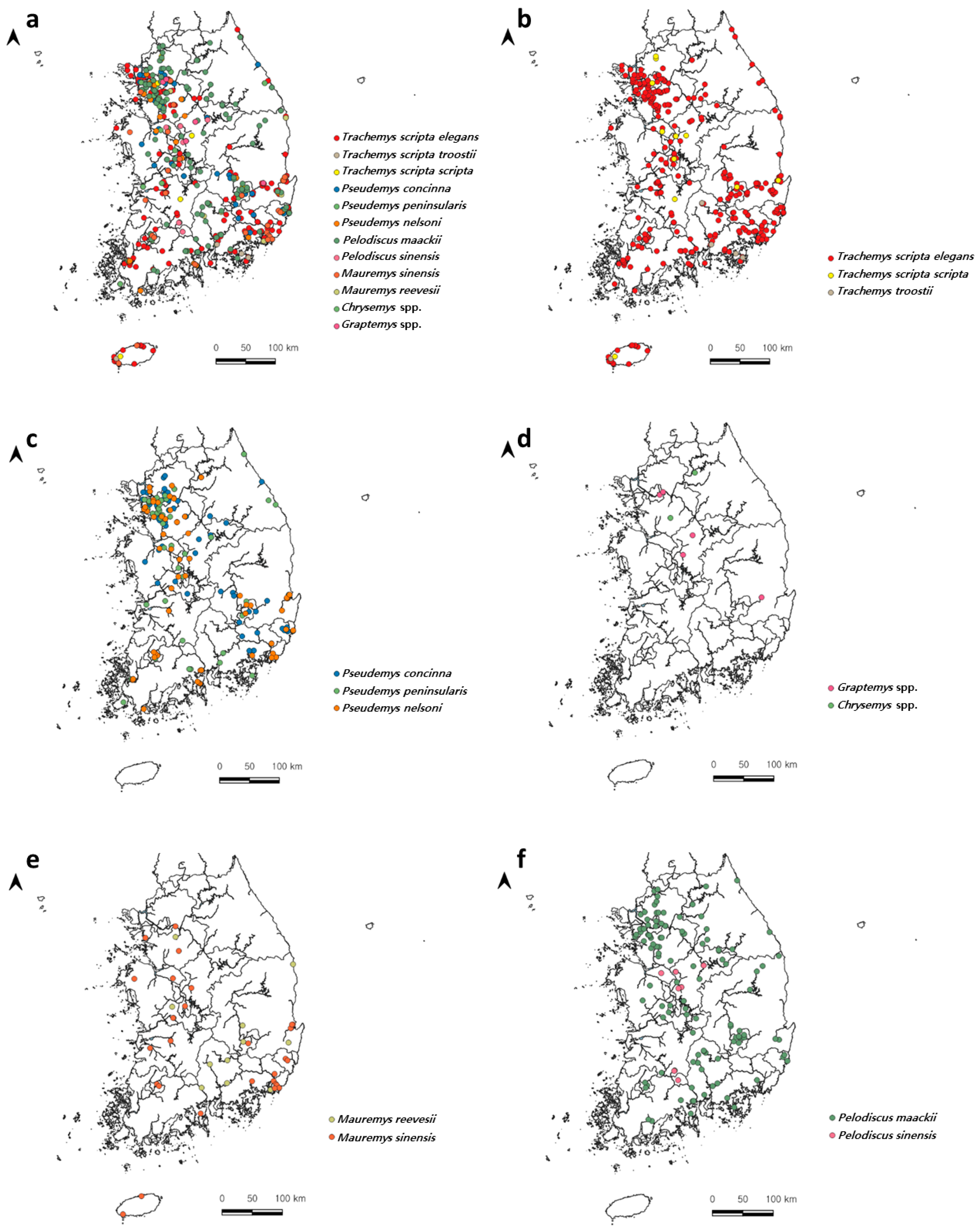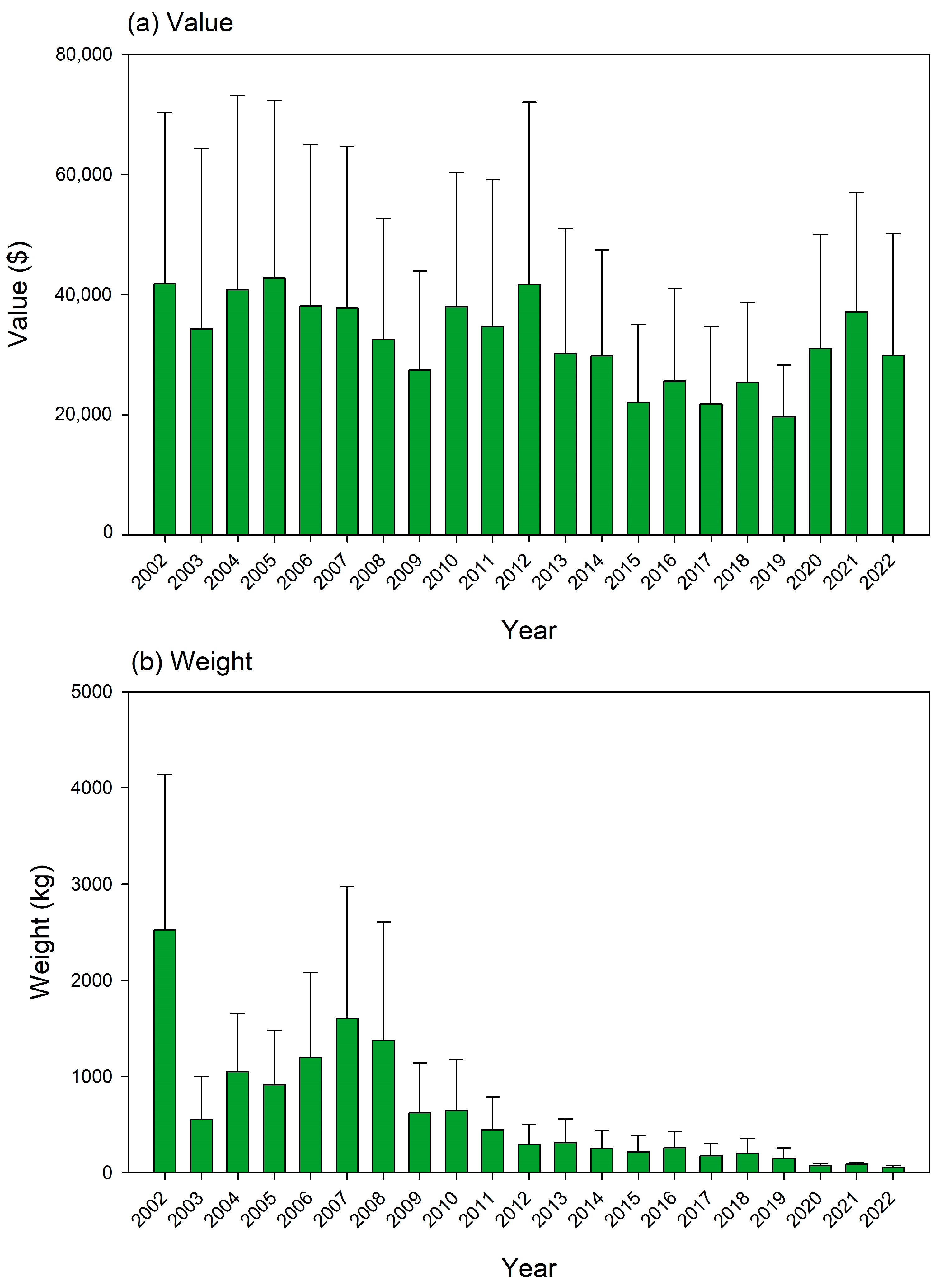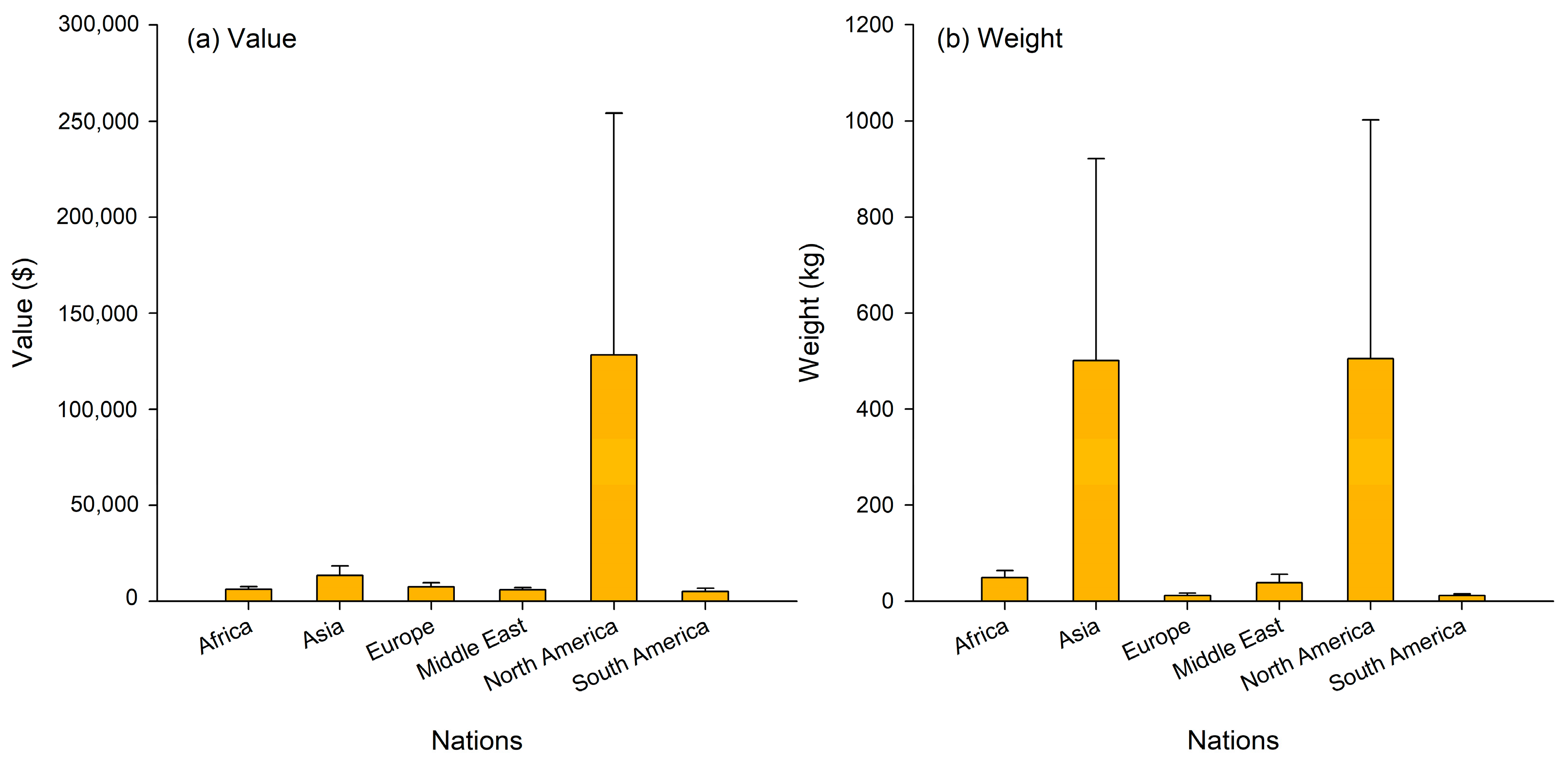Domestic Reutilization Status of Invasive Turtle Species in South Korea Based on Trachemys scripta
Abstract
1. Introduction
2. Materials and Methods
2.1. Distribution of T. scripta and Other Alien Turtles in South Korea
2.2. Turtle Sales Status in Traditional Markets
2.3. Management Status of Turtles Retrieved from the Wild
2.4. Import Status of Invasive Alien Turtles and Data Analysis
3. Results
3.1. Distribution of T. scripta and Other Alien Turtles in South Korea
3.2. Sales Status of Turtles in Traditional Markets
3.3. Management Status of Turtles Retrieved from the Wild
3.4. Import Status of Turtles for 21 Years
4. Discussion
5. Conclusions
Supplementary Materials
Author Contributions
Funding
Institutional Review Board Statement
Data Availability Statement
Acknowledgments
Conflicts of Interest
References
- Thomson, S.A. Turtles of the world: Annotated checklist and atlas of taxonomy, synonymy, distribution, and conservation status. Phyllomedusa J. Herpetol. 2021, 20, 225–228. [Google Scholar] [CrossRef]
- Lovich, J.E.; Ennen, J.R.; Agha, M.; Gibbons, J.W. Where have all the turtles gone, and why does it matter? BioScience 2018, 68, 771–781. [Google Scholar] [CrossRef]
- Stanford, C.B.; Rhodin, A.G.J.; van Dijk, P.P.; Horne, B.D.; Blanck, T.; Goode, E.V.; Hudson, R.; Mittermeier, R.A.; Currylow, A.; Eisemberg, C.C.; et al. Turtles in Trouble: The World’s 25+ Most Endangered Tortoises and Freshwater Turtles—2018; Turtle Conservation Coalition, Hemlock Printers: Burnaby, BC, Canada, 2018. [Google Scholar]
- Garber, S.D.; Burger, J. A 20-yr study documenting the relationship between turtle decline and human recreation. Ecol. Appl. 1995, 5, 1151–1162. [Google Scholar] [CrossRef]
- Koo, K.S.; Song, S.; Choi, J.H.; Sung, H.C. Current distribution and status of non-native freshwater turtles in the wild, Republic of Korea. Sustainability 2020, 12, 4042. [Google Scholar] [CrossRef]
- National Institute of Ecology. Monitoring of Invasive Alien Species Designated by the Act on the Conservation and Use of Biological Diversity (VI); Ministry of Environment: Seocheon, Republic of Korea, 2022; pp. 61–69.
- Kraus, F. Alien Reptiles and Amphibians: A Scientific Compendium and Analysis; Springer: Dordrecht, The Netherlands, 2009. [Google Scholar]
- National Institute of Ecology. Investigation Ecological Risk of Alien Species; Ministry of Environment: Seocheon, Republic of Korea, 2021; pp. 93–113.
- National Institute of Ecology. Information for the Field Management of Invasive Alien Species in Korea; Ministry of Environment: Seocheon, Republic of Korea, 2021; pp. 36–41.
- Roy, H.E.; Rabitsch, W.; Scalera, R. Study on Invasive Alien Species–Development of Risk Assessments to Tackle Priority Species and Enhance Prevention. Final Report; European Union: Luxembourg, 2018; Available online: https://op.europa.eu/en/publication-detail/-/publication/c01568d9-025e-11e8-b8f5-01aa75ed71a1/language-en (accessed on 13 December 2022).
- Ramsay, N.F.; Ng, P.K.A.; O’Riordan, R.M.; Chou, L.M. The red-eared slider (Trachemys scripta elegans) in Asia: A review. In Biological Invaders in Inland Waters: Profiles, Distribution, and Threats; Gherardi, F., Ed.; Springer: Dordrecht, The Netherlands, 2007; pp. 161–174. [Google Scholar] [CrossRef]
- Koo, K.S.; Park, H.R.; Choi, J.H.; Sung, H.C. Present status of non-native amphibians and reptiles traded in Korean online pet shop. Korean J. Environ. Ecol. 2020, 34, 106–114. [Google Scholar] [CrossRef]
- Tobin, P.C. Managing invasive species. F1000Research 2018, 7, 1686. [Google Scholar] [CrossRef] [PubMed]
- Larson, D.L.; Phillips-Mao, L.; Quiram, G.; Sharpe, L.; Stark, R.; Sugita, S.; Weiler, A. A framework for sustainable invasive species management: Environmental, social, and economic objectives. J. Environ. Manag. 2011, 92, 14–22. [Google Scholar] [CrossRef] [PubMed]
- Pimentel, D.; Zuniga, R.; Morrison, D. Update on the environmental and economic costs associated with alien-invasive species in the United States. Ecol. Econ. 2005, 52, 273–288. [Google Scholar] [CrossRef]
- Kraus, F. Impacts from invasive reptiles and amphibians. Annu. Rev. Ecol. Evol. Syst. 2015, 46, 75–97. [Google Scholar] [CrossRef]
- Levine, J.M.; Vilà, M.; D’Antonio, C.M.; Dukes, J.S.; Grigulis, K.; Lavorel, S. Mechanisms underlying the impacts of exotic plant invasions. Proc. R. Soc. B Biol. Sci. 2003, 270, 775–781. [Google Scholar] [CrossRef]
- Wilcove, D.S.; Rothstein, D.; Dubow, J.; Phillips, A.; Losos, E. Quantifying threats to imperiled species in the United States: Assessing the relative importance of habitat destruction, alien species, pollution, overexploitation, and disease. BioScience 1998, 48, 607–615. [Google Scholar] [CrossRef]
- Teillac-Deschamps, P.; Delmas, V.; Lorrillière, R.; Servais, V.; Cadi, A.; Prévot-Julliard, A.C. Red-eared slider turtles (Trachemy scripta elegans) introduced to French urban wetlands. An integrated research and conservation program. Herpetol. Conserv. 2008, 3, 535–537. Available online: https://orbi.uliege.be/bitstream/2268/28797/1/TiellacCS12.pdf (accessed on 23 February 2023).
- Kim, P.; Yeun, S.; An, H.; Kim, S.H.; Lee, H. Breeding status and management system improvement of Pseudemys concinna and Mauremys sinensis designated as invasive alien turtles in South Korea. Ecol. Resilient Infrastruct. 2020, 7, 388–395. [Google Scholar]
- Oh, H.S.; Hong, C.E. Current conditions of habitat for Rana catesbeiana and Trachemys scripta elegans imported to Jeju-do, including proposed management plans. Korean J. Environ. Ecol. 2007, 21, 311–317. [Google Scholar]
- SPSS. IBM SPSS Statistics for Windows, version 24.0; IBM Corp.: Armonk, NY, USA, 2016.
- Bang, J.H. Who Did the Bad Things to Turtle and His Shell? Maeil Shinmun, 14 June 2012. Available online: http://mnews.imaeil.com/page/view/2012061410461163218 (accessed on 10 January 2023).
- Kim, H.J. ‘Poor Release, It Hurts Me.’ Call of the Red-Eared Slider. Brainworld Korea, 24 May 2012. Available online: https://www.brainmedia.co.kr/BrainTraining/9197 (accessed on 10 January 2023).
- Park, J.H. Respect for Life through Release? Rather Kill Life. OhmyNews, 29 February 2016. Available online: http://www.ohmynews.com/NWS_Web/View/at_pg.aspx?CNTN_CD=A0002185995 (accessed on 10 January 2023).
- Park, G.E. Named on the Turtle Shell with Paint and Release It?…“Killing, Not Releasing.” Nocutnews, 24 December 2019. Available online: https://www.nocutnews.co.kr/news/5263572 (accessed on 10 January 2023).
- Park, Y.S. [Camera News] Freshwater Turtle Abandoned in the Sea with Red Writing on the Plastron. Yonhapnews, 10 February 2020. Available online: https://www.yna.co.kr/view/AKR20200210116400062 (accessed on 10 January 2023).
- Choi, H.J. ‘The Plastron is Full of People’s Name’ Why Do Freshwater Turtles Go to Sea. Ilyo, 28 April 2022. Available online: https://m.ilyo.co.kr/?ac=article_view&entry_id=427395 (accessed on 10 January 2023).
- Shiu, H.; Stokes, L. Buddhist animal release practices: Historic, environmental, public health and economic concerns. Contemp. Buddhism 2008, 9, 181–196. [Google Scholar] [CrossRef]
- Holler, D. The ritual of freeing lives. In Proceedings of the Ninth Seminar of the IATS, 2000. Volume 2: Religion and Secular Culture in Tibet; Brill Academic Pub: Leiden, The Netherlands, 2002; pp. 207–226. [Google Scholar] [CrossRef]
- Chen, J.M.; Lin, M.L.; Suen, M.W. Individuals’ Knowledge, Beliefs, Attitudes, and Behaviors toward Animal Releasing. Sociol. Mind 2014, 4, 298–304. [Google Scholar] [CrossRef][Green Version]
- Masin, S.; Bonardi, A.; Padoa-Schioppa, E.; Bottoni, L.; Ficetola, G.F. Risk of invasion by frequently traded freshwater turtles. Biol. Invasions 2014, 16, 217–231. [Google Scholar] [CrossRef]
- Kopecký, O.; Kalous, L.; Patoka, J. Establishment risk from pet-trade freshwater turtles in the European Union. Knowl. Manag. Aquat. Ecosyst. 2013, 410, 02. [Google Scholar] [CrossRef]




| Species | Individuals | Points (Cities) | Designation |
|---|---|---|---|
| Trachemys scripta | 1440 (66%) | 295 (103) | EDS |
| 1-1. Trachemys scripta elegans | 1360 (63%) | 280 (100) | EDS |
| 1-2. Trachemys scripta scripta | 58 (3%) | 40 (26) | EDS |
| 1-3. Trachemys scripta troostii | 22 (1%) | 12 (10) | EDS |
| Pseudemys concinna | 371 (17%) | 124 (64) | EDS |
| Pseudemys nelsoni | 136 (6%) | 57 (36) | EDS |
| Pseudemys peninsularis | 164 (8%) | 80 (43) | |
| Mauremys sinensis | 45 (2%) | 29 (19) | EDS |
| Chrysemys picta picta | 1 | 1 (1) | |
| Chrysemys dorsalis | 1 | 1 (1) | |
| Graptemys pseudogeographica | 3 | 3 (3) | |
| Graptemys ouachitensis | 2 | 2 (2) | |
| Pelodiscus sinensis | 11 | 7 (6) | |
| Total | 2174 | 341 (109) |
| Market | Species | Carapace Length (cm) | Value ($) | Individuals Sold |
|---|---|---|---|---|
| Cheonggyecheon (Seoul Metropolitan) | Pseudemys peninsularis | 5–10 | - | 100 ↑ |
| Chrysemys picta picta | 5–10 | - | 100 ↑ | |
| Kinosternon subrubrum | 5–10 | - | 50 ↑ | |
| Moran Market (Seongnam-si) | Trachemys scripta elegans | 30 ↑ | 39–118 | 5 |
| Trachemys scripta scripta | 20 | 39 | 1 | |
| Pseudemys concinna | - | 39–118 | 6 | |
| Pseudemys peninsularis | 20–40 | 39–118 | 3 | |
| Jayu Market (Mokpo-si) | Trachemys scripta elegans | 20–40 | - | 12 |
| Jayang Market (Gyeongsan-si) | Pelodiscus sinensis | 20–40 | 39–118 | 4 |
| Chilseong Market (Daegu Metropolitan) | Pelodiscus sinensis | 20–40 | 11–15 | 20 |
| Seomun Market (Daegu Metropolitan) | Pseudemys concinna | 20–30 | 31–39 | 2 |
| Mauremys sinensis | 20–30 | 31–39 | 2 | |
| Chrysemys picta bellii | 5–10 | 19 | 40 | |
| Sternotherus carinatus | 15 | 31–39 | 1 | |
| Emydura subglobosa | 15 | 31–39 | 1 | |
| Gwanmun Market (Daegu Metropolitan) | Trachemys scripta elegans | 20–40 | 31–39 | 10 |
| Pseudemys concinna | 20–40 | 23–39 | 5 | |
| Pseudemys nelsoni | 20–40 | 23–39 | 2 | |
| Mauremys sinensis | 20–40 | 23–39 | 1 | |
| Pelodiscus sinensis | 20–40 | 23–39 | 15 | |
| Bujeon Market (Busan Metropolitan) | Trachemys scripta elegans | 5–20 ↑ | 11–15 | 36 |
| Pseudemys concinna | 15 | 11 | 1 | |
| Mauremys sinensis | - | 15 | 6 | |
| Mauremys maackii | - | 15 | 1 | |
| Pelodiscus sinensis | - | 31/kg | 80 | |
| Sternotherus carinatus | 5 | 7 | 1 | |
| Dongnae Market (Busan Metropolitan) | Trachemys scripta elegans | 20–30 | - | 5 |
| Pseudemys concinna | 20 | - | 1 |
| Species | Adoption | Release | Return | Donation | Advertisement | Total | F-Value | p-Value |
|---|---|---|---|---|---|---|---|---|
| Trachemys scripta | 29 | 1 | 2 | 2 | 34 | |||
| 1-1. Trachemys scripta elegans | 21 | 1 | 2 | 2 | 26 | |||
| 1-2. Trachemys scripta scripta | 6 | 6 | ||||||
| 1-3. Trachemys scripta troostii | 2 | 2 | ||||||
| Pseudemys concinna | 4 | 4 | ||||||
| Pseudemys nelsoni | 4 | 1 | 1 | 6 | ||||
| Pseudemys peninsularis | 20 | 3 | 1 | 1 | 25 | |||
| Mauremys sinensis | 4 | 4 | ||||||
| Chrysemys spp. | ||||||||
| Sternotherus carinatus | 1 | 1 | ||||||
| Podocnemis unifilis | 1 | 1 | ||||||
| Pelomedusa subrufa | 1 | 1 | ||||||
| Carettochelys insculpta | 1 | 1 | ||||||
| Pelodiscus maackii | 1 | 4 | 5 | |||||
| Chelydra serpentina | 8 | 1 | 2 | 11 | ||||
| Unidentified | 11 | 1 | 1 | 2 | 15 | |||
| Total cases | 7.1 ± 2.2 a | 0.6 ± 0.3 b | 0.2 ± 0.1 b | 0.6 ± 0.2 b | 0.4 ± 0.2 b | 8.9 ± 2.6 b | 8.728 | <0.001 |
| Year | Number of Countries | Value ($) | Weight (kg) |
|---|---|---|---|
| 2002 | 5 | 208,846 | 12,620 |
| 2003 | 6 | 205,691 | 3329 |
| 2004 | 7 | 285,471 | 7356 |
| 2005 | 7 | 298,998 | 6406 |
| 2006 | 8 | 304,912 | 9556 |
| 2007 | 10 | 377,421 | 16,064 |
| 2008 | 13 | 423,538 | 17,922 |
| 2009 | 17 | 465,876 | 10,588 |
| 2010 | 15 | 570,234 | 9736 |
| 2011 | 18 | 623,751 | 8002 |
| 2012 | 20 | 833,614 | 5952 |
| 2013 | 24 | 724,737 | 7533 |
| 2014 | 26 | 775,223 | 6611 |
| 2015 | 30 | 659,849 | 6528 |
| 2016 | 36 | 920,438 | 9440 |
| 2017 | 35 | 762,864 | 6181 |
| 2018 | 32 | 810,020 | 6512 |
| 2019 | 34 | 668,850 | 5115 |
| 2020 | 28 | 869,089 | 2031 |
| 2021 | 32 | 1,187,869 | 2768 |
| 2022 | 23 | 806,731 | 1473 |
Disclaimer/Publisher’s Note: The statements, opinions and data contained in all publications are solely those of the individual author(s) and contributor(s) and not of MDPI and/or the editor(s). MDPI and/or the editor(s) disclaim responsibility for any injury to people or property resulting from any ideas, methods, instructions or products referred to in the content. |
© 2023 by the authors. Licensee MDPI, Basel, Switzerland. This article is an open access article distributed under the terms and conditions of the Creative Commons Attribution (CC BY) license (https://creativecommons.org/licenses/by/4.0/).
Share and Cite
Baek, H.-J.; Cho, S.; Seok, M.; Shin, J.-W.; Kim, D.-I. Domestic Reutilization Status of Invasive Turtle Species in South Korea Based on Trachemys scripta. Diversity 2023, 15, 885. https://doi.org/10.3390/d15080885
Baek H-J, Cho S, Seok M, Shin J-W, Kim D-I. Domestic Reutilization Status of Invasive Turtle Species in South Korea Based on Trachemys scripta. Diversity. 2023; 15(8):885. https://doi.org/10.3390/d15080885
Chicago/Turabian StyleBaek, Hae-Jun, Soyeon Cho, Minjeong Seok, Joo-Won Shin, and Dae-In Kim. 2023. "Domestic Reutilization Status of Invasive Turtle Species in South Korea Based on Trachemys scripta" Diversity 15, no. 8: 885. https://doi.org/10.3390/d15080885
APA StyleBaek, H.-J., Cho, S., Seok, M., Shin, J.-W., & Kim, D.-I. (2023). Domestic Reutilization Status of Invasive Turtle Species in South Korea Based on Trachemys scripta. Diversity, 15(8), 885. https://doi.org/10.3390/d15080885






